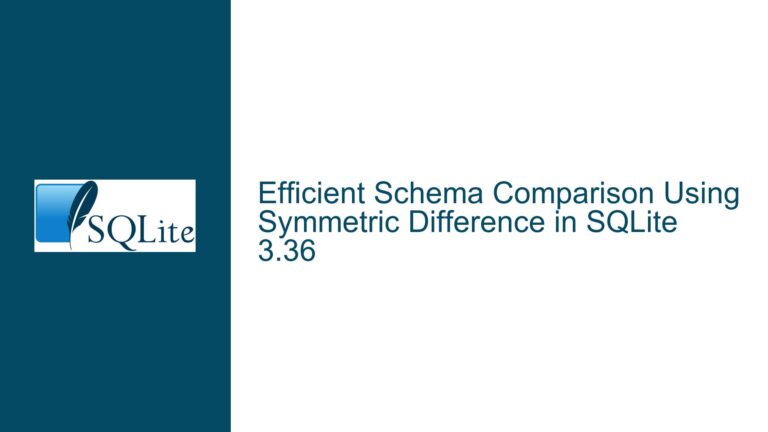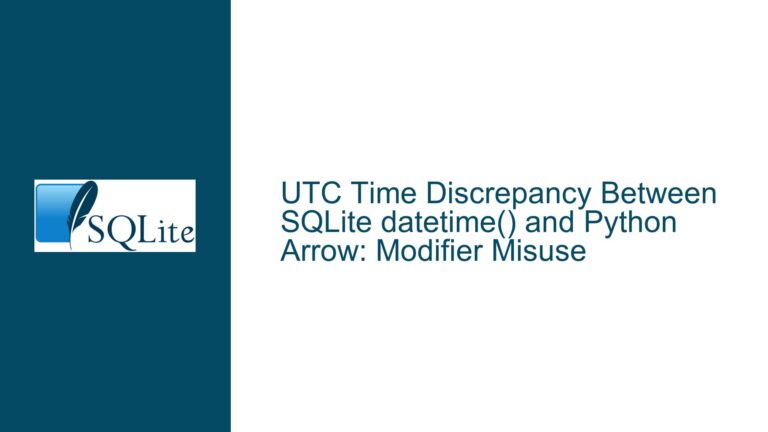SQLite generate_series Function Missing: Causes and Workarounds
SQLite generate_series Function Not Found in Version 3.33
The generate_series function is a table-valued function that generates a sequence of values between a specified start and end point, incrementing by a given step. This function is particularly useful for generating sequences of numbers, dates, or other ordered data within SQL queries. However, users of SQLite version 3.33 may encounter the error "no such table: generate_series" when attempting to use this function. This issue arises because the generate_series function, although documented as part of the SQLite command-line shell, was not actually included in the shell until a later version.
The generate_series function is implemented as a loadable extension in SQLite. Loadable extensions are external modules that can be dynamically loaded into SQLite to extend its functionality. The series extension, which provides the generate_series function, is included in the SQLite source tree but must be explicitly compiled and loaded into the SQLite environment to be used. In SQLite version 3.33, the series extension was not compiled into the command-line shell by default, leading to the "no such table" error when users attempt to call generate_series.
This issue is further complicated by the fact that the documentation for SQLite version 3.33 incorrectly states that the generate_series function is included in the command-line shell. This documentation error persisted until the release of SQLite version 3.34, which correctly includes the series extension in the shell. As a result, users of version 3.33 are left without access to the generate_series function unless they take additional steps to compile and load the extension manually.
Missing Series Extension in SQLite 3.33 Shell
The root cause of the "no such table: generate_series" error in SQLite version 3.33 is the absence of the series extension in the command-line shell. The series extension, which provides the generate_series function, is a loadable extension that must be compiled and loaded into SQLite to be used. In SQLite version 3.33, this extension was not compiled into the shell by default, leading to the error when users attempt to call generate_series.
The series extension is part of the SQLite source tree, specifically located in the ext/misc/series.c file. To use the generate_series function in SQLite version 3.33, users must manually compile this extension and load it into their SQLite environment. This process involves downloading the SQLite source code, locating the series.c file, compiling it into a loadable extension, and then loading the extension into SQLite using the LOAD EXTENSION command.
Additionally, the documentation for SQLite version 3.33 incorrectly states that the generate_series function is included in the command-line shell. This documentation error likely contributed to user confusion, as users expected the function to be available without additional steps. The documentation was corrected in SQLite version 3.34, which includes the series extension in the shell by default.
Another factor contributing to this issue is the timing of the release of SQLite version 3.33. The series extension was added to the SQLite source tree after the release of version 3.33, meaning that users of this version did not have access to the extension unless they manually compiled and loaded it. This situation was resolved with the release of SQLite version 3.34, which includes the series extension in the shell by default.
Compiling and Loading the Series Extension or Using Recursive CTEs
To resolve the "no such table: generate_series" error in SQLite version 3.33, users have two primary options: compiling and loading the series extension manually or using recursive common table expressions (CTEs) as an alternative to the generate_series function.
Compiling and Loading the Series Extension
To compile and load the series extension, users must first obtain the SQLite source code. The source code can be downloaded from the SQLite website or cloned from the SQLite GitHub repository. Once the source code is obtained, users should locate the series.c file, which is typically found in the ext/misc/ directory.
The next step is to compile the series.c file into a loadable extension. This process requires a C compiler and the SQLite development headers. On Unix-like systems, the following command can be used to compile the extension:
gcc -g -fPIC -shared series.c -o series.so
On Windows, the process is slightly different and may require the use of a tool like MinGW or Microsoft Visual Studio. Once the extension is compiled, it can be loaded into SQLite using the LOAD EXTENSION command:
.load /path/to/series.so
After the extension is loaded, the generate_series function will be available for use in SQL queries. For example, the following query will generate a sequence of numbers from 1 to 10:
SELECT * FROM generate_series(1, 10, 1);
Using Recursive Common Table Expressions (CTEs)
For users who prefer not to compile and load the series extension, recursive common table expressions (CTEs) provide a standard SQL alternative to the generate_series function. Recursive CTEs allow users to generate sequences of values using standard SQL syntax, making them a portable solution that works across different SQL database engines.
To generate a sequence of numbers from 1 to 10 using a recursive CTE, the following query can be used:
WITH RECURSIVE c(x) AS (
VALUES(1)
UNION ALL
SELECT x+1 FROM c WHERE x<10
)
SELECT x FROM c;
This query defines a recursive CTE named c that starts with the value 1 and increments by 1 until the value 10 is reached. The final SELECT statement retrieves the generated sequence of numbers.
Recursive CTEs can also be used to generate sequences of dates or other ordered data. For example, the following query generates a sequence of dates starting from January 1, 2023, and ending on January 10, 2023:
WITH RECURSIVE c(date) AS (
VALUES('2023-01-01')
UNION ALL
SELECT date(date, '+1 day') FROM c WHERE date<'2023-01-10'
)
SELECT date FROM c;
This query uses the date function to increment the date by one day in each iteration of the recursive CTE.
Comparison of Approaches
The following table compares the two approaches to generating sequences in SQLite:
| Approach | Pros | Cons |
|---|---|---|
| Compiling and Loading Series | Direct access to generate_series function; efficient for large sequences | Requires manual compilation and loading; not portable across databases |
| Recursive CTEs | Standard SQL syntax; portable across databases | More verbose syntax; may be less efficient for very large sequences |
Conclusion
The "no such table: generate_series" error in SQLite version 3.33 is caused by the absence of the series extension in the command-line shell. Users can resolve this issue by either compiling and loading the series extension manually or using recursive common table expressions (CTEs) as an alternative. The choice between these approaches depends on the user’s specific needs and preferences, with the series extension offering a more direct solution and recursive CTEs providing a portable, standard SQL alternative.






